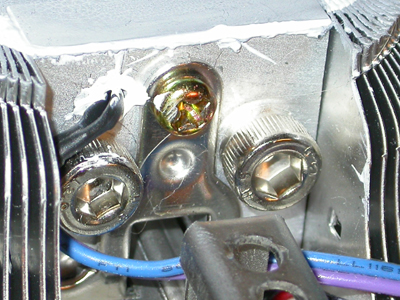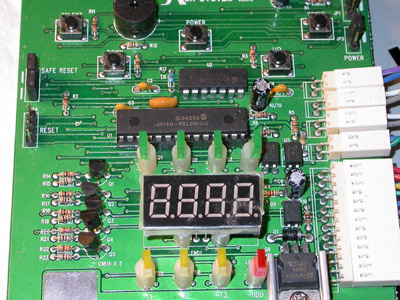CPU Heat Comparison: How Hot is Prescott?
by Derek Wilson on April 16, 2004 4:32 AM EST- Posted in
- CPUs
Heatsink Modding: The New Rage
Our solution to the problem is admittedly a bit of a kludge. Nothing is perfect, but we really wanted numbers that were going to get us some useable data, so we needed to get as close to measuring the surface temperature of a processor as possible.We decided to drill a hole in a heatsink and drop in a thermister.
Our heatsink of choice was the Zalman CNPS7000A-AlCu. In order to get something consistent between processors, we wanted to measure the temperature at the center of the heatsink close to the surface that would contact the processor. We drilled in from the side of the block to the center of the copper strip. Since the retention mechanism was held in by a screw in the center of the side, we had to go in at an angle. Please do not try this at home, as flying metal shards and angled drilling into a block of metal are not things we want to be sued over should something go wrong. Here's a look at what we ended up with:

This is a close up of the side of our modded heatsink.
This heatsink fit on all the processors we wanted to test, and we were assured that degrading its cooling ability a little by drilling a hole in it would still allow it to keep the CPUs cool enough to run. We hooked up a thermistor that came with a case we had, and since it was already set up for displaying temps, we forewent building a reader for it ourselves and just ripped out the front panel as well.

This is the front panel display we used to read the temperatures.
Some care needs to be taken when reading the data that we collected using this heatsink. First of all, this isn't a measure of the heat output of a processor. This is a measurement of the temperature at a specific position in an open system. Having the misfortune of suffering through a thermodynamics class in college isn't always a bad thing (except with respect to one's GPA), but what this means is that these numbers still aren't perfect. The processor is heating the bottom of the heatsink, while the fan is cooling the rest of it. Even though the heat is being distributed through the heatsink, if there is a hot or cold spot very close to the position from which the thermister was reading temperatures, the data could be off for that particular processor. Because we are heating and cooling this object at the same time, the equilibrium temperature we find at this position may not be directly proportional to the heat output of the chip.
But, with all that said, this is still better than using the on die thermistor or monitoring change in system temperature. Our tests were performed in a temperature controlled room with no case on the computer. In order to load the processors, we ran two simultaneous instances of Prime95 for 40 minutes (though temperatures stabilized after about 25). Our idle temperatures were taken after powering up and doing nothing for 30 minutes (no power saving options were enabled).










48 Comments
View All Comments
PrinceGaz - Friday, April 16, 2004 - link
Interesting article, but I've a couple of suggestions :)If the fan on the heatsink was plugged into the motherboard used to test the CPU, you should instead run it off a dedicated stable regulated power source given an accurate known voltage. That totally isolates any effect the motherhoard, PSU load or anything else might have on HSF efficiency.
All current and future CPUs we're interested in have a heatspreader, which presumably does a decent job of spreading the heat over a fairly wide surface area compared to core-size of the processor (the AthlonXP/Duron line is effectively finished and won't concern enthusiasts, so their energy-consumption isn't too important). It seems a good way to translate recorded temperature over ambient temperature, into an actual power consumption in watts would be to make a little heater unit (with something like a heatspreader) you can mount the HSF on.
By adjusting the voltage applied to it and measuring the current you could take a whole range of readings covering a wide range of watts. You'd not only know whether the temperature difference rises linear with power, but also be able to give actual wattage figures for the CPUs. At least one site (whose name evades me) which does extensive HSF testing actually uses such a heater type system to compare HSF performance to ensure identical conditions.
From the results I must say I'm impressed with how well the Athlon 64 CPUs did, especially when running Prime95. Was Cool 'n Quiet enabled to reduce their speed in idle mode? If it was, I assume you did ensure with some utility they were operating at full speed while Prime95 was running? ;)
Prime95 is a great way to heat up processors but it may have a different impact on different CPU designs. The P4 runs it *FAR* faster than the AthlonXP does, or even the Athlon 64 despite the latter also having SSE2 instructions (which Prime95 uses). In particular have a look at the benchmarks page:
http://www.mersenne.org/bench.htm
and you'll see that for equivalent tests, the time taken by some different CPUs were:
Athlon XP 3200+ - 0.032, 0.066, 0.142
Athlon 64 3400+ - 0.025, 0.052, 0.116
Northwood 3.2GHz - 0.013, 0.026, 0.056
The Northwood 3.2GHz is running Prime95 roughly twice as fast as even the Athlon 64 3400+. Now while I can't say for sure that running it faster translates into more power-consumption, the fact that the test runs so much faster on that design makes the results difficult to trust. If however you've tried a whole bunch of different stress-test programs on the Athlon 64, Northwood and Prescott and found Prime95 gave the hottest temperatures on them all, thats fine. But if different tests give the hottest temperature for each design, then thats the one you should use for that design when carrying out future tests.
Sorry for rambling on so long, hope some of that made sense :)
CRAMITPAL - Friday, April 16, 2004 - link
http://www.theinquirer.net/?article=15374CRAMITPAL - Friday, April 16, 2004 - link
Obviously no one with a clue would buy a PressCrap when it clearly runs much hotter than the Northwood and is actually SLOWER in system performance. In InHell marketing speak that's called "90 nano performance". Sic !!! Now inHell is doing damage control after lower than expected profits and defective products they can't even deliver in quantity to Dull and WasteGate.Mumrik - Friday, April 16, 2004 - link
I meant an articles that claim the AXP only has a difference of 1Mumrik - Friday, April 16, 2004 - link
Doesn't seem very well done....How can we trust results that claim the AXP2500+ only have an idle/load temperature difference of 1 degree celcius?!
Pumpkinierre - Friday, April 16, 2004 - link
You didnt include the ambient air temp close to the fan (and fan speed- maximum or silent). Northwood temp range seems high. Cpu case temperature can be 10C under internal/diode temp.. 5C or so difference, both idle and load, between N'wood and Prescott is quite significant to an overclocker. The die size is approx. the same but given the 'missing 30 million transistors', 90nm and the large cache, the heat might be more localised on the Prescott affecting headroom. Good to see the a64 data. These AMD cpus seem to run cool.Voodoo80 - Friday, April 16, 2004 - link
What about cool and quiet? It's a pity this is not tested. I want to know what the idle temps would be if this is enabled.MAME - Friday, April 16, 2004 - link
Awww, I was hoping it'd be a heat nightmare and AMD would come to save the day!